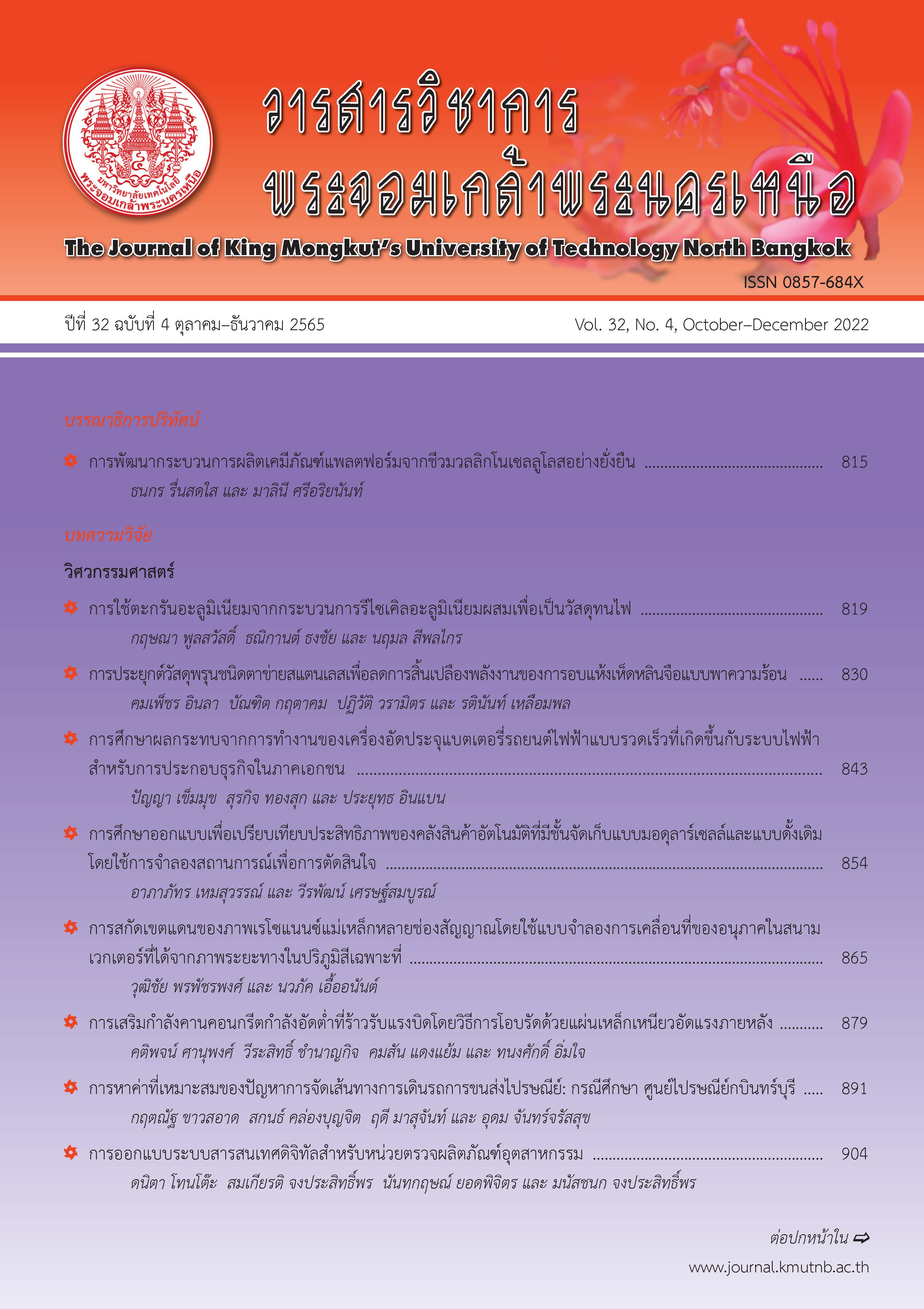ฤทธิ์ต้านอนุมูลอิสระของสละและการพัฒนาเป็นผลิตภัณฑ์สบู่
Main Article Content
บทคัดย่อ
พืชสกุลสละ เป็นหนึ่งในพืชที่มีความสำคัญทางเศรษฐกิจของประเทศไทย ซึ่งกระบวนการแปรรูปพืชสกุลนี้ทำให้เกิดเปลือกและเมล็ดสละเป็นของเหลือใช้ทางการเกษตรจำนวนมาก งานวิจัยนี้จึงมีวัตถุประสงค์เพื่อศึกษาการใช้ประโยชน์จากเปลือกและเมล็ดของสละด้วยการทดสอบฤทธิ์ต้านอนุมูลอิสระของเปลือกและเมล็ดของพืชสกุลสละและพัฒนาเป็นผลิตภัณฑ์สบู่ก้อนที่มีฤทธิ์ต้านอนุมูลอิสระ โดยได้คัดกรองฤทธิ์ต้านอนุมูลอิสระ DPPH ของพืชสกุลสละ 5 ชนิด คือ ระกำ สละกำ สละหม้อ สละเนินวง และสละสุมาลี ผลการวิจัยพบว่าสารสกัดเอทานอลของเปลือกพืชสกุลสละมีฤทธิ์ต้านอนุมูลอิสระสูงกว่าเมล็ดอย่างมีนัยสำคัญทางสถิติ (P≤0.05) และเปลือกสละสุมาลีมีฤทธิ์ต้านอนุมูลอิสระสูงสุด โดยพบว่าเปลือกสละสุมาลีมีฤทธิ์ต้านอนุมูลอิสระสูงใกล้เคียงวิตามินซี (IC50 1.03+-0.04 ไมโครกรัมต่อมิลลิลิตร) และสูงกว่าเมล็ดและเนื้อสละ โดยมีค่า IC50 เท่ากับ 7.93+-0.04 99.22+-0.51 และ 353.98+-1.70 ไมโครกรัมต่อมิลลิลิตร ตามลำดับ นอกจากนี้สารสกัดเอทานอลของเปลือกสละสุมาลียังแสดงฤทธิ์ยับยั้งเอนไซม์ไทโรซิเนสสูงกว่าเมล็ดและเนื้อสละ โดยมีค่า IC50 เท่ากับ 419.80+-3.22 1821.62+-6.69 และมากกว่า 1000 ไมโครกรัมต่อมิลลิลิตร ตามลำดับ แต่ต่ำกว่าสารมาตรฐานโคจิก (IC50 1.18+-0.24 ไมโครกรัมต่อมิลลิลิตร) เมื่อนำสารสกัดเอทานอลของเปลือกสละสุมาลีมาผสมในสบู่กลีเซอรีนแบบก้อนใสและก้อนขุ่นพบว่าสบู่ทั้งสองชนิดมีฤทธิ์ต้านอนุมูลอิสระแต่น้อยกว่าสารสกัดเอทานอลก่อนการผสม โดยมีค่า IC50 เมื่อใช้เอทานอลเป็นตัวทำละลายสบู่เท่ากับ 351.13+-24.74 และ 347.56+-18.71 ไมโครกรัมต่อมิลลิลิตร ตามลำดับ
Article Details

อนุญาตภายใต้เงื่อนไข Creative Commons Attribution-NonCommercial-NoDerivatives 4.0 International License.
บทความที่ลงตีพิมพ์เป็นข้อคิดเห็นของผู้เขียนเท่านั้น
ผู้เขียนจะต้องเป็นผู้รับผิดชอบต่อผลทางกฎหมายใดๆ ที่อาจเกิดขึ้นจากบทความนั้น
เอกสารอ้างอิง
E. A. N. K. E. Susila, I. G. A. P. I. Udayani, and S. M. A. Negeri, “Salacca coffee made of snake fruit seed waste from Paradise island,” presented at the International Conference of young scientists Cluj- napoca, Romania, 16–22 April, 2016.
M. S. M. Saleh, M. J. Siddiqui, A. Mediani, N. H. Ismail, Q. U. Ahmed, S. Z. M. So'ad, and S. Saidi-Besbes, “Salacca zalacca: A short review of the palm botany, pharmacological uses and phytochemistry,” Asian Pacific Journal of Tropical Medicine, vol. 11, pp. 645–652, 2018.
S. Gorinstein, S. Poovarodom, H. Leontowicz, M. Leontowicz, J. Namiesnik, S. Vearasilp, R. Haruenkit, P. Ruamsuke, E. Katrich, and Z. Tashma, “Antioxidant properties and bioactive constituents of some rare exotic Thai fruits and comparison with conventional fruits In vitro and in vivo studies,” Food Research International, vol. 44, pp. 2222–2232, 2011.
S. Aralas, M. Mohamed, and M. F. A. Bakar, “Antioxidant properties of selected salak (Salacca zalacca) varieties in Sabah, Malaysia,” Nutrition & Food Science, vol. 39, pp. 243–250, 2009.
I. R. Suica-Bunghez, S. Teodorescu, I. D. Dulama, O. C. Voinea, S. Simionescu, and R. M. Ion, “Antioxidant activity and phytochemical compounds of snake fruit (Salacca Zalacca),” presented at the IOP Conference Series: Materials Science and Engineering, vol. 133, International Conference on Innovative Research - ICIR Euroinvent 2016 19–20 May 2016, Iasi, Romania, 2016.
E. Rohaeti, M. R. Fauzi, and I. Batubara, “Inhibition of α-glucosidase, total phenolic content and flavonoid content on skin fruit and flesh extracts of some varieties of snake fruits,” IOP Conference Series: Earth and Environmental Science, vol. 58, pp. 1–6, 2017.
L. H. A. Priyatno, E. Y. Sukandar, S. Ibrahim, and I. K. Adnyana, “Antihyperuricemic effect of ethanol extract of snake fruit (Salacca edulis Reinw.) var. Bongkok on wistar male rat,” Journal of Food Science and Engineering, vol. 2, pp. 271– 276, 2012.
A. Tilaar, A. Ranti, and A. Mun’im, “The efficacy study of snake fruit (Salacca edulis Reinw var. Bongkok) extract as skin lightening agent,” Pharmacognosy Journal, vol. 9, pp. 235–238, 2017.
N. Moonrungsee, N. Peamaroon, A. Boonmee, S. Suwancharoen, and J. Jakmunee, “Evaluation of tyrosinase inhibitory activity in Salak (Salacca zalacca) extracts using the digital image-based colorimetric method,” Chemical Papers, vol. 72, pp. 2729–2736, 2018.
M. Kanlayavattanakul, N. Lourith, D. Ospondpant, U. Ruktanonchai, S. Pongpunyayuen, and C. Chansriniyom, “Salak plum peel extract as a safe and efficient antioxidant appraisal for cosmetics,” Bioscience Biotechnology and Biochemistry, vol. 77, pp. 1068–1074, 2013.
G. A. Ayoola, H. A. B. Coker, S. A. Adesegun, A. A. AdepojuBello, K. Obaweya, E. C. Ezennia, and T. O. Atangbayila, “Phytochemical screening and antioxidant activities of some selected medicinal plants used for malaria therapy in Southwestern Nigeria,” Tropical Journal of Pharmaceutical Research, vol. 7, pp. 1019–1024, 2008.
E. Girsang, I. N. E. Lister, C. N. Ginting, A. Khu, B. Samin, W. Widowati, S. Wibowo, and R. Rizal, “Chemical constituents of snake fruit (Salacca zalacca (Gaert.) Voss) peel and in silico anti-aging analysis,” Molecular and Cellular Biomedical Sciences, vol. 3, pp. 122–128, 2019.
F. B. M. Wazir, “Determination of total flavonoids, total phenolic and ascorbic acid content in fresh and cooked Longan (Dimocarpus longan Lour.), Nutmeg (Myristica fagrans) and Snake fruit (Salacca edulis Reinw.) seeds,” Bachelor dissertation. Faculty of apply science, Universiti Teknologi MaRa, 2012.
M. S. M. Saleh, M. J. A. Siddiqui, A. Khatib, and S. Mat, “Phytochemical constituents, α-glucosidase inhibitory activity and preliminary acute toxicity studies of the ethanol-water extracts of Salacca zalacca fruits in rats,” presented at the 1st International Symposium on Herbal Medicine, Pre-conference of 3rd AMDI International Biohealth Sciences Conference (IBSC), Kuching, Sarawak, 2018.
P. Achayuthakan, “The development of glycerin soap from Carissa carandas L.,” (Research report). Suan Sunandha Rajabhat University, 2017 (in Thai).
S. Raksaphort, S. Suwancharoen, R. Sawangkeaw, K. Samart, and J. Boontao, “Value-added spent coffee grounds to produce caffeinated soap,” KKU Science Journal, vol. 46, pp. 38–43, 2018 (in Thai).
S. Sangkao, A. Khwanwong, N. Khonthong, K. Jaidee, N. Chumruay, A. Pachai, M. Meepripruk, and N. Buadee, “Antioxidant activity, Ascorbic acid content and the consumer satisfaction of Aloe Vera mixed honey soap: Phayaprai herbs Amphoe Muang,” The Golden Teak: Science and Technology Journal, vol. 4, pp. 119–126, 2017 (in Thai).
W. M. A. N. K. Wijetung and B. G. K. Perera, “Preparation of medicinal soap products using the leaf extracts of Punica granatum (Pomegranete),” International Journal of Phamacy and Biological Sciences, vol. 6, pp. 2321–2372, 2016.

